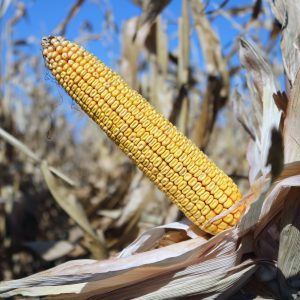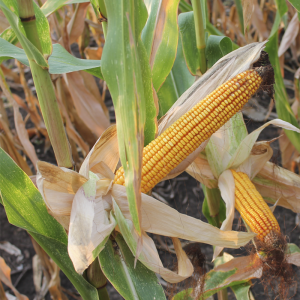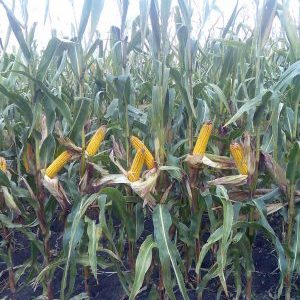Characteristics and description of a hybrid of corn seeds Krasnodar 291 AMV
Corn is the oldest plant in the cereal family, native to Central and South America. Now it is one of the three grain crops in the world. It contains a large amount of beneficial vitamins and minerals. There are many varieties and hybrids of this cereal. The article will tell you about the Krasnodar 291 AMV hybrid: how to cultivate it, take care of it, what are its advantages and disadvantages.
The content of the article
Corn Krasnodar 291 AMV
The hybrid Krasnodar 291 was bred in the Krasnodar Research Institute of Agriculture named after P.P. Lukyanenko... This is a modified tall culture of medium early maturation. The crop yield per hectare is 120 centners. The period of growth and maturation is about 3-3.5 months.
Product type
The hybrid is included in the State Register for cultivation for grain and silage in the Central, Central Black Earth, North Caucasian regions. In the classification of the International Organization for Food and Agriculture (FAO) it belongs to the group of medium early type 290. The hybrid has yellow tooth-like grains.
Characteristics and description of the hybrid
Hybrid Krasnodar 291 tolerates drought well, adapts to different growing conditions, tolerates changes in air temperature and at the same time gives a high yield.
The indicators of the modified culture are as follows:
- height up to 2 m;

- the ear is formed at a height of 60 to 80 cm;
- up to 18 large leaves grow on the stem base, has from 10 to 12 ground nodes between the sections of the stem;
- a cylindrical ear with 14 rows of grains, the weight of an ear containing 1000 grains is 280-300 g;
- after threshing grain yield - from 80 to 82%;
- the hybrid is resistant to bladder smut and marsupial fungus, which causes stem rot (fusarium);
- the plant is drought-resistant, with a plant density of up to 60,000 plants per hectare.
- the breeding of the hybrid is based on the cytoplasmic male sterility of the seeds;
- eaten stewed, boiled, used as feed for cattle;
- grown in the Southern Federal District (Krasnodar, Stavropol Territories, the Republic of Adygea), Volgo-Vyatka region.
Seed dressing and packing
Corn seeds Krasnodar 291 are treated with Maxim XL fungicide. This drug protects the plant from diseases:
- root rot;
- stem rot;
- dusty smut;
- mold;
- ascochitis.
Corn is packed in polyethylene bags of 25 kg (70,000 seeds in 1 package).
Features of sowing and cultivation
Corn is an unpretentious plant, therefore it does not need special planting methods. If you follow agrotechnical rules, the harvest will be rich. A dry and open plot of land that is not blown by strong winds is selected for this cereal crop.
It is better to plant the plant in the soil where pumpkin, potatoes, peas, and beans used to grow. They begin to prepare soil for planting in the fall, after harvesting. To lower the level of soil acidity, liming is carried out - 10 m² of land is treated with 2-3 kg of fluff lime. Dig up, adding a bucket of sand, peat, humus or manure to 1 m² of land. Digging the soil is repeated in the spring - add potassium sulfate, superphosphate, urea (nitrogen fertilizer).
Sowing recommendations:
- Before planting corn, the soil is loosened to get rid of weeds. From seeds, corn is best grown in the southern regions.In other regions, it is worth using the seedling method.

- They begin to plant seeds when the soil temperature warms up to + 10 ° C - in the last decade of April or early May.
- It is better to germinate the seeds before planting in the ground. For this, the grains are processed with special preparations ("Regoplant", "Biolan", "Radostim") or with a solution of manganese permanganate, placed in a jar (they are not covered with a lid). Seeds are poured with settled water, which is drained after 12 hours. The container with grains is covered with a fabric that does not allow air to pass through and is constantly moistened so that the seeds do not die.
- It is recommended to sow corn in a well-heated soil at a distance of 50x40 cm between rows, 15-20 cm between holes.
- Place in a hole 3-6 cm deep, 3-4 seeds. When the plant has sprouted, weak shoots are removed and 1-2 strong ones are left for greater resistance to lodging.
- It is recommended to plant the plant in 4 rows for better pollination. If there is no cross-pollination, then this process is performed manually - the pollen is shaken off into a bag, and then poured onto the embryo of an ear of corn. The procedure is repeated 3 to 4 times in the morning.
So that the plant is not weak, its crops are sprayed with growth stimulants ("Biolan", "Zeastimulin", "Stimpo"), chemical agents intended for pest control and plant diseases by adding liquid fertilizers and trace elements.
Top dressing of a cereal crop is carried out 3 weeks after planting: an aqueous solution of cow manure or bird droppings is used (1 liter of manure per bucket of water). Foliar top dressing is carried out with a solution of carbamide - 1 tbsp. l. on a bucket of water.
Hybrid Krasnodar 291 does not require a lot of moisture. Water abundantly until a panicle is formed - this ensures that the fruits will be juicy in the future. Watering stops in August.
Factors affecting the maturation of corn:
- growing region;
- planting time in the soil;
- ripening conditions.
Advantages and disadvantages of a hybrid
Hybrid Krasnodar 291 has the following advantages:
- resistant to a large number of pathogenic fungi and bacteria that cause stem rot, affecting leaves and ears;
- has large cobs, convenient for transportation, which are long are keptwithout losing their qualities;
- high yield in the Southern Federal District and the North Caucasus.
There are also disadvantages:
- susceptible to bacteriosis caused by the causative agent of the disease by the bacterium Vakillus;
- has no resistance to the corn moth (hemp worm of the moth family).
Young ears of the Krasnodar 291 hybrid are stored for no more than 3 weeks in a cool room, with a storage temperature of 0 ° C. If the temperature rises, then their taste is lost.
Storage and use
Correct storage of corn is the preservation of a large amount of nutrients and taste. Gardeners who have extensive experience in growing this crop are advised to store this cereal crop not with grains in jars, but with cobs. There are 4 ways to store corn cobs.
In the freezer
Storage this way prolongs the shelf life of the fetus, but the deadline is 1.5 years. The ears are thawed gradually at room temperature. Dousing with hot water is not recommended - it will affect the taste of the corn.
Before placing corn in the refrigerator, we recommend:
- prepare 2 small containers, pour very cold water into one container, boiling water into the second;
- peel the cobs of leaves and fibers and soak alternately in cold and hot water (2-4 minutes each), the procedure is repeated several times;
- put corn on a napkin and let dry at room temperature;
- wrap the prepared ears in plastic wrap, put them in containers and store them in the freezer.
Dry
In this way, only ripe corn is stored and no more than a year. It is cleaned of part of the leaves and antennae so that it does not deteriorate quickly.The ears are hung in the open air. At temperatures below + 10 ° C, the fruits are brought into the room and dried in well-ventilated rooms so that the penetration of sunlight is maximized - in the veranda or attic. This method preserves well the integrity of the grains from which the corn porridge is prepared.
Canning the ears
The way in which the fruits are stored for a long time: from 2 to 3 years, if the sterilization rules are followed. Before capping corn into jars boil, taken out of water, wrapped with cling film and placed in the refrigerator for 3 days. This method preserves the flavor and juiciness of the corn kernels.
Canning corn kernels
First, the grains are placed in a pre-sterilized jar, poured with warm boiled water (salt is added to taste). Then the containers are closed with nylon lids and placed in the basement (cellar). After 2-3 days, the cans are raised from the cellar, water is added, and lowered for another 5 months. Housewives use such canned corn in salads.
How much corn on the cob is cooked
The time it takes to boil the ears depends on at what stage of ripening they were picked.
Fresh, young corn has a light yellow shade of cob - it is cooked 15-20 minutes after the start of the boil.
For cereals with dark grains, the cooking time is from 40 minutes to 1.5 hours (depending on the size of the cob and the amount in the pot). In order for the corn to cook well, it is completely immersed in a container of water and covered with a lid. Readiness is checked grain by grain: if it is freely pierced with a match, then the product is ready for use.
Where can I buy
A hybrid Krasnodar 291 is for sale in different regions of Russia where this crop is grown - in the Krasnodar, Stavropol Territories, and the Rostov Region. The cost for one landing unit is from 2,100 to 3,000 rubles.
Reviews
We bring to your attention a few reviews from experienced farmers.
Alexey, Art. Bryukhovetskaya, Krasnodar Territory: “I have been sowing the Krasnodar 291 hybrid for several years. These are grains of excellent quality, which give a high yield. All seeds are the same size. There is no special care - weeding, hilling, irrigation. Delicious boiled ears. "
Taisiya, Rostov-on-Don: “Several years ago, the summer was dry. And I did not expect that my Krasnodar 291 would be able to withstand such heat. But the watered cereals did not die in time. The harvest was rich, we ate the tasty culture with pleasure, and preserved 20 cans ”.
Victor, Dzhankoy: “Well adapted cereal. It is in no way inferior to imported varieties. The yield is high - not less than 102 centners per hectare for several years. The manufacturer makes recommendations to increase the yield. "
Conclusion
Krasnodar 291 AMV is one of the best hybrids that quickly adapts to weather conditions, is not susceptible to many plant diseases, and has a high yield. It is nutritious and useful for health, as it contains valuable vitamins and minerals.